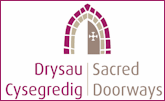Church of Ss Beuno & Mary, Whitford
It’s thought that a church was founded at this site (a short detour off the North Wales Pilgrim’s Way) by St Beuno in the 7th century. The oldest written record of Widford church is in the Domesday Book of 1086. The first stone church at this site may have been built in that century.
During the 13th century, the church suffered war damage as the English fought the Welsh. The church later received 13 shillings for repairs. Whitford church may have been dedicated to St Beuno before the Normans dedicated it to St Mary. Now it’s dedicated to both saints.
The oldest elements of the church we see today – in the north aisle – date from the 15th or 16th century. The church was rebuilt in the 1840s, and much of the work was funded by the Pennant and Mostyn families. There are many memorials to members of those families at the church including a marble memorial for the travel and nature writer Thomas Pennant, buried here in 1798.
His illustrator, Moses Griffith, was buried in the churchyard in 1819. He hailed from Gwynedd and was a self-taught artist. In 1783 Thomas Pennant, in his role as magistrate, sentenced local resident Frances Williams to death for stealing items from Moses Griffith. The sentence was reduced, and in 1787 she became the first Welsh woman to be transported to Australia.
The south lychgate unusually has a chamber above, dated 1624. Inside the church are remnants of ancient tomb slabs, along with a large sandstone cross from the 12th century or earlier.
The village’s war memorial is inside the church.




